Risley - Village and City
w/e 13 July 2008
All this week's pictures were taken
with a Kodak DX6490
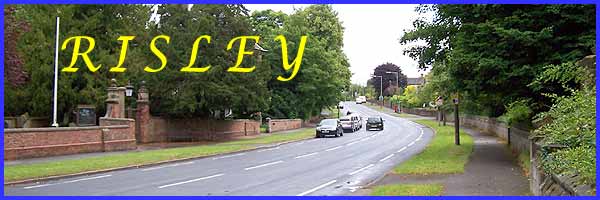
It would be unkind to say that Risley is just the
western extension of Sandiacre on the road towards Derby but
to be fair, a casual visitor would be likely to gain that impression.
Much of the traffic that once would have used this road now utilises
the faster and much busier A52 road to the south that links Derby
and Nottingham. Even those travellers that do venture off the
Brian Clough Way and through the village will probably be heading
for a hotel and know little of the village's history which dates
back beyond the Domesday Book. In those days the name was spelt
Rislie or Riseleie and was derived from "hris" the
Old English and Old Scandinavian for brushwood and "leah",
Old English for a woodland clearing.
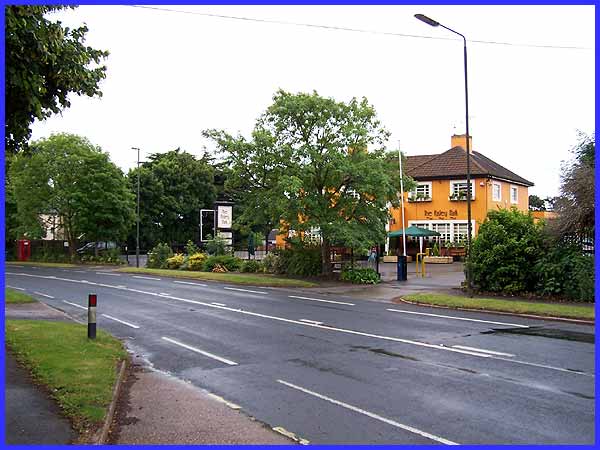
The "brushwood clearing" has probably long since disappeared
and been filled with a variety of buildings. One of the first
to been seen on entering the village from the Derby side is the
Risley Park that now contains a bar, restaurant and function
rooms. I still remember it along with many others I suppose,
as the Blue Ball pub but its outward appearance has benefited
from a coat of paint, barriers across the car park and increased
planting in its step upmarket.
|
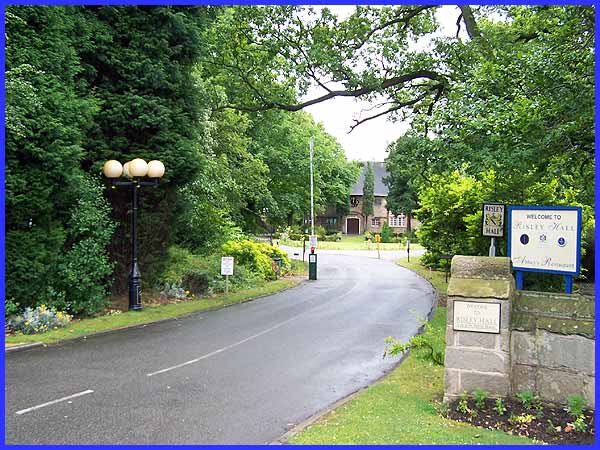
Another nearby building that has undergone a transformation is
the Risley Hall Hotel. In the not too distant past this was run
by the Nottingham Corporation as an approved school for boys.
Within the grounds of the hotel as well as a nursing home and
some private dwellings, the Treetops Hospice that cares for the
terminally ill can also be found.
|

But even prior to being an approved school Risley Hall had a
long history dating back to the 16th century when it was held
by the celebrated navigator Sir Hugh Willoughby, who sailed in
the 1550s in search of a north-east passage. Tragically he and
his crew were frozen to death in the January following their
departure. The Hall was rebuilt around 1725 after the original
was destroyed, it is thought, by fire leaving only the balustrade
and gateway on the terrace from the original building.
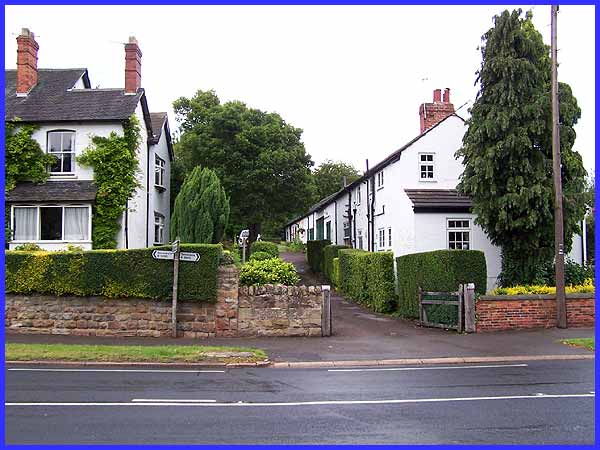
Not as old as the original Hall but certainly dating from an
age before many of the houses that line the main road, these
cottages standing opposite the Risley Hall site, although at
the opposite end of the housing scale to the great house they
face, are probably just as desirable in the today's housing market
as the Hall itself.
|
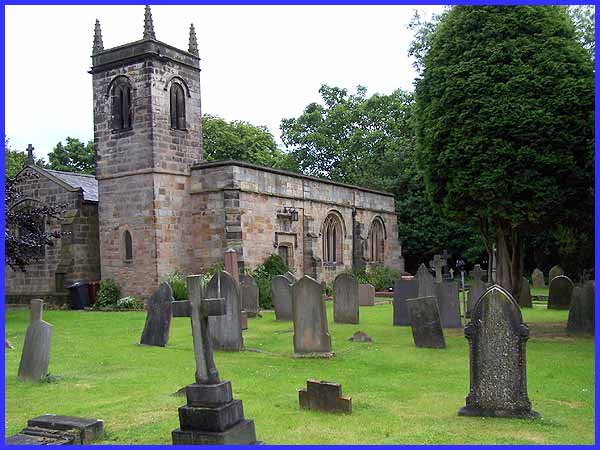
Also opposite the Hall site is All Saints Church which is unusual
in that it is one of only six in England that was built when
most churches were being demolished. Whilst researching the history
of Risley I have to admit to being a little confused by the dates.
It is said that the church has its origins in 1350 when it was
built by the Willoughby family who resided in Risley Hall but
we have already seen the the Hall was not built until the 16th
century. Another source says the church is "Elizabethan"
and was built by Sir Michael Willougby, Lord of the manor of
Risley and his wife Katherine. Elizabeth I reigned from 1533
until 1603 which of course tallies with the date of the Hall
so I'm still not sure whether the church dates from the 14th
or the 16th century. Either way the Willoughby family were instrumental
in its foundation.
|
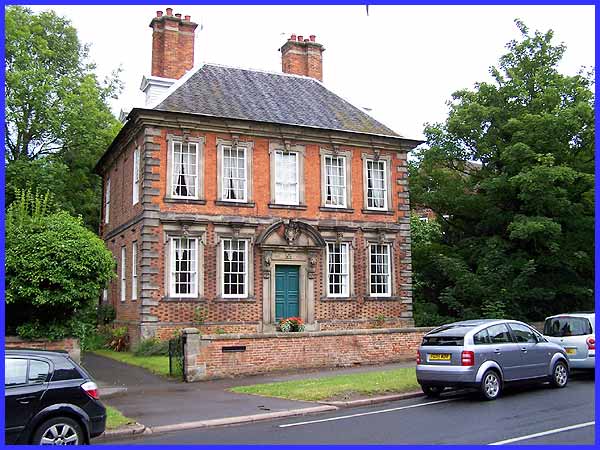
Next to the church is the Latin House. This again has connections
with the Willoughby family for it was Katherine Willoughby who
founded a free school in 1583 and left money in her will to educate
children. Dame Elizabeth Grey, her great-great grand niece was
responsible for this building plus some other associated buildings
in the early 18th century. Risley Latin School was built in 1732
and the Latin House pictured above at one time housed a Grammar
School.
|
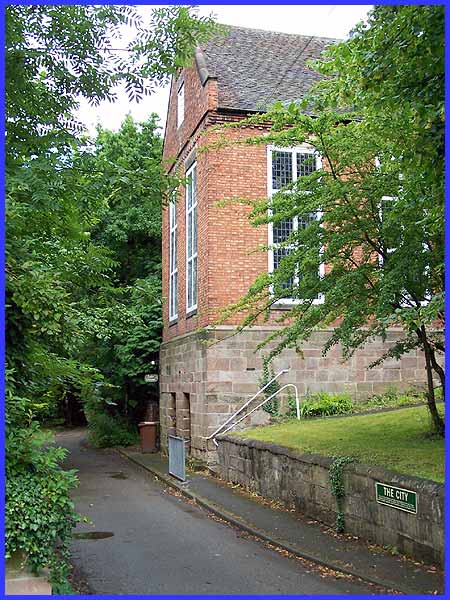
One of the other associated buildings stands on the other side
of a narrow lane at the side of the Latin House and this is called
the Latin College. The lane is somewhat euphemistically called
The City and the inscription of the nameplate reads "Site
of the first settlement of Riselei, being from the Latin 'Civitas'
meaning citadel. Over time this became 'Cite' in Old English.
A citadel would have existed hereabouts to protect the village's
livestock." And that explains why Risley can be both a village
and a city.
|
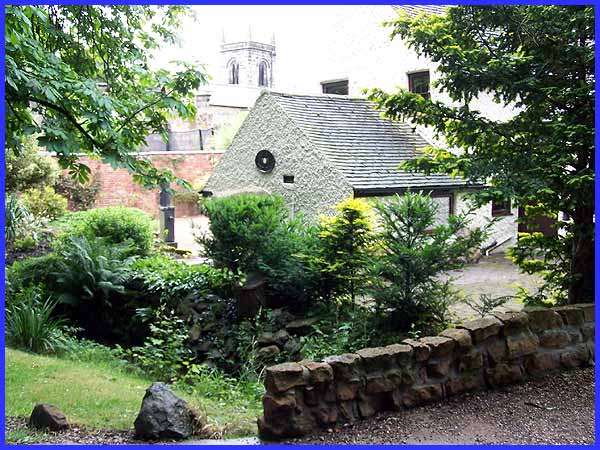
A little way into The City a cottage stands by a babbling brook
crossed both by a ford and a small footbridge. With the church
tower as a backdrop it is really a world away from the trappings
of modern life but the circular plaque on the cottage wall gives
a clue to when it was a focal point in the village. It reads
"The Old Post Office." 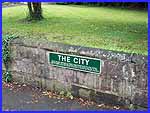 Ethel
Hulse has written a book titled "Life at 'Our End' of Risley"
which is a personal account from the 1920s and in which she paints
some wonderfully evocative pictures from that time. Of this area
she writes "The brook was a big attraction there, to
be jumped over instead of using the bridge. Nearby the lovely
conker tree stood and behind the Post Office .... a row of quaint
cottages. Up the brook we paddled, taking our nets to catch minnows
which we put in a jam jar, releasing them again into the water
before we went home." Proceeds from the sale of the
book are in aid of the Treetops Hospice. Ethel
Hulse has written a book titled "Life at 'Our End' of Risley"
which is a personal account from the 1920s and in which she paints
some wonderfully evocative pictures from that time. Of this area
she writes "The brook was a big attraction there, to
be jumped over instead of using the bridge. Nearby the lovely
conker tree stood and behind the Post Office .... a row of quaint
cottages. Up the brook we paddled, taking our nets to catch minnows
which we put in a jam jar, releasing them again into the water
before we went home." Proceeds from the sale of the
book are in aid of the Treetops Hospice.
|
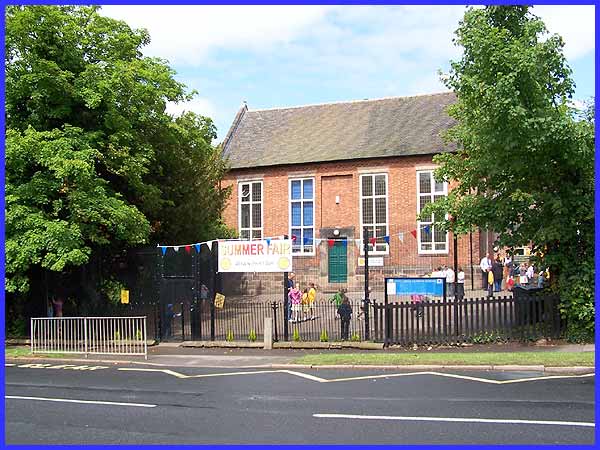
Returning to the main road the next and final building in this
selection of images from Risley is the present school building.
Again with more than a passing nod to the Willoughby family this
dates from 1753 when it was known as the English School. With
bunting and a banner advertising the Summer Fair, the pupils
are obviously not stuck in the past but it is perhaps worth recalling
here one last important historical fact. In 1729 near the Hall,
a Romano-British silver plate was discovered. It measured twenty
inches by fifteen and is thought to have belonged to a church
in France in 405AD. Now on display in the British Museum it is
known as the Risley Lanx. So as you can see, there IS much more
to Risley than first meets the eye.
|

